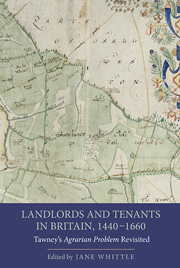Book contents
- Frontmatter
- Contents
- List of Figures
- List of Tables
- Abbreviations
- List of Contributors
- Acknowledgements
- Foreword
- Introduction: Tawney's Agrarian Problem Revisited
- 1 The Agrarian Problem, 1440–1520
- 2 Common Law and Manor Courts: Lords, Copyholders and Doing Justice in Early Tudor England
- 3 Negotiating Enclosure in Sixteenth-Century Yorkshire: The South Cave Dispute, 1530–1536
- 4 The Politics of Enclosure in Elizabethan England: Contesting ‘Neighbourship’ in Chinley (Derbyshire)
- 5 The Loss of Athelstan's Gift: The Politics of Popular Memory in Malmesbury, 1607–1633
- 6 In Search of the Scottish Agrarian Problem
- 7 The Transfer to Leasehold on Durham Cathedral Estate, 1541–1626
- 8 The Financial Rewards of Winning the Battle for Secure Customary Tenure
- 9 Risks and Rewards in Wasteland Enclosure: Lowland Lancashire c.1500–1650
- 10 Improving Landlords or Villains of the Piece? A Case Study of Early Seventeenth-Century Norfolk
- 11 The Agrarian Problem in Revolutionary England
- 12 Agrarian Capitalism and Merchant Capitalism: Tawney, Dobb, Brenner and Beyond
- Conclusions
- Select Bibliography
- Index
9 - Risks and Rewards in Wasteland Enclosure: Lowland Lancashire c.1500–1650
Published online by Cambridge University Press: 05 September 2013
- Frontmatter
- Contents
- List of Figures
- List of Tables
- Abbreviations
- List of Contributors
- Acknowledgements
- Foreword
- Introduction: Tawney's Agrarian Problem Revisited
- 1 The Agrarian Problem, 1440–1520
- 2 Common Law and Manor Courts: Lords, Copyholders and Doing Justice in Early Tudor England
- 3 Negotiating Enclosure in Sixteenth-Century Yorkshire: The South Cave Dispute, 1530–1536
- 4 The Politics of Enclosure in Elizabethan England: Contesting ‘Neighbourship’ in Chinley (Derbyshire)
- 5 The Loss of Athelstan's Gift: The Politics of Popular Memory in Malmesbury, 1607–1633
- 6 In Search of the Scottish Agrarian Problem
- 7 The Transfer to Leasehold on Durham Cathedral Estate, 1541–1626
- 8 The Financial Rewards of Winning the Battle for Secure Customary Tenure
- 9 Risks and Rewards in Wasteland Enclosure: Lowland Lancashire c.1500–1650
- 10 Improving Landlords or Villains of the Piece? A Case Study of Early Seventeenth-Century Norfolk
- 11 The Agrarian Problem in Revolutionary England
- 12 Agrarian Capitalism and Merchant Capitalism: Tawney, Dobb, Brenner and Beyond
- Conclusions
- Select Bibliography
- Index
Summary
In his Agrarian Problems, Eric Kerridge accused R. H. Tawney of conjuring up a sixteenth century characterised by ‘a relentless and remorseless capitalism which impiously rode down a wretched peasantry’. Certainly no one could accuse Tawney of equivocation in terms of his Christian Socialist views: and it is not too hard to find forthright quotations in The Agrarian Problem, such as his dismissal of the Edwardian Riot Act as ‘a straightforward attempt to prevent the poor from protesting when their possessions were taken from them by the rich’. Yet Tawney's views were perhaps more nuanced than he is sometimes given credit for. Thus he distinguished piecemeal enclosure from ‘the great enclosures made by lords of manors from which the peasants obviously lost’ – the ‘obviously’ being a typical Tawneian touch – while he made it clear that, when talking of enclosure, he meant converting open arable fields to pasture, which he claimed ‘the word would have suggested to nine men out of ten in our period’.
Yet depopulating enclosure was a regional phenomenon: and it is with the tenth man's interpretation that this chapter is concerned. Although far from Tawney's main focus, there are in fact numerous references in the Problem to wasteland enclosure. Perhaps unusually, he seems to have seen piecemeal enclosure as a win-win situation – ‘the lord gained by leasing part of it [the waste] to be broken up and cultivated while, so long as sufficient land was left for grazing, the tenants gained by getting land which they could add to their holdings and on which a growing population could settle’.
- Type
- Chapter
- Information
- Landlords and Tenants in Britain, 1440-1660Tawney's 'Agrarian Problem' Revisited, pp. 150 - 165Publisher: Boydell & BrewerPrint publication year: 2013



